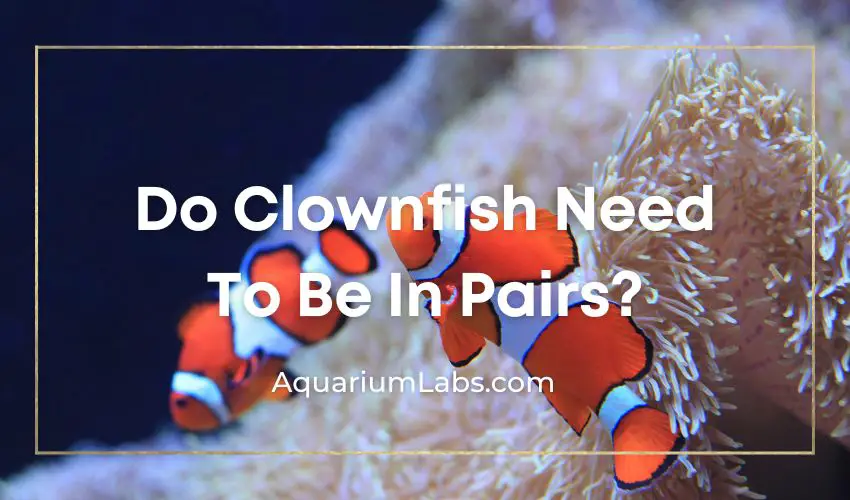Clownfish are a group of damselfish (family Pomacentridae) that are world-famous for their many unique qualities. The many different species in this group are often called anemone fish because of their love of bonding with a sea anemone.
But did you know that many clownfish live together as pairs or even groups of multiple clownfish? As colorful as they are, keeping clownfish together in groups can be even more exciting than a single clownfish!
When looking into a tank full of clownfish getting a pair might look like an impossible task. After all, they look close to identical, especially when they are all the same age. So what do you need to know about pairing these popular saltwater fish successfully?
Do Clownfish Need To Be In Pairs?
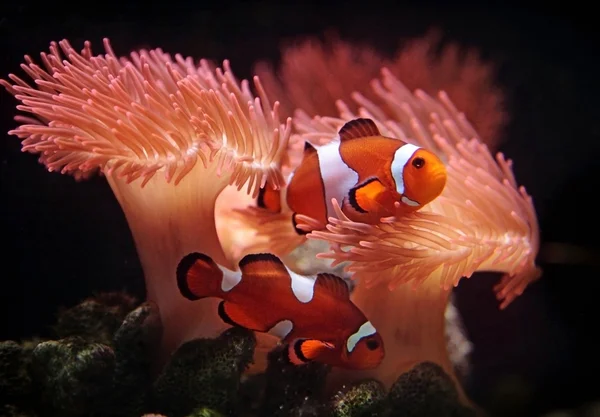
I recommend keeping multiple clownfish in the same tank whenever you can do so. Clownfish are intensely social with others of the same species. In fact, they will often socialize even with other species of clownfish when kept in the same saltwater aquarium.
A few are even willing to share the same anemone. Clarkii Clownfish (Amphiprion clarkii) and Pink Skunk Clownfish (Amphiprion perideraion) are famous for being willing to share space with other species.
But keeping a clownfish pair is a lot easier to do, especially if your aquarium is not especially large. Clownfish don’t always get along with one another, even those of the same species. Often you can even find clownfish in pairs in pet stores.
Sometimes they are collected as a male and female clownfish duo in the wild. But they sometimes spontaneously pair up in a pet store aquarium, especially if they are captive bred.
Are Clownfish Social With Each Other?
As I mentioned earlier, clownfish are very social with one another. They establish a pecking order that determines which fish is socially dominant and which are subordinate. This pecking order is very important because social dynamics also determine clownfish sex, which I will discuss in greater detail below!
Are Clownfish Social With Other Fish?
Clownfish usually keep to themselves in an aquarium. This is one reason why they are such popular community fish: clownfish are very peaceful and won’t harass other fish. They are also gentle towards most invertebrates, including shrimp, clams, corals, and starfish.
That said, there are a few exceptions. The Maroon Clownfish (Premnas biaculeatus) happens to be the largest clownfish, growing up to 8 inches long. It is also the one that commonly exhibits aggressive behavior towards other fish.
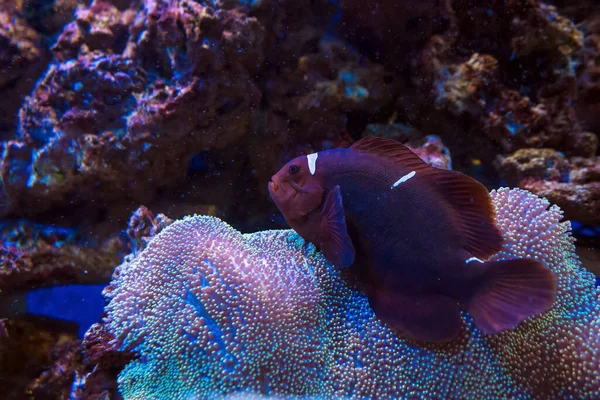
Adult female clownfish of this breed are so aggressive they sometimes bite the fingers of their owners as they try to clean the inside of the aquarium! And they can make life very difficult for the other fish sharing their aquarium.
Can A Clownfish Live Alone?
Maybe you already have a single clownfish living alone in an aquarium. Or perhaps you just don’t have a bigger tank for too many clownfish. In that case, you can keep a single clownfish alone.
They won’t become unduly stressed unless they were part of a mating pair, in which case the new fish will be stressed and likely hide for a while. But so long as there are other fish in the same aquarium to indicate that all is well, a single clownfish will eventually acclimate and come out of hiding.
If you do decide to keep one fish alone, I recommend adding a sea anemone to give it an extra sense of security. Sea anemones are not easy to keep, but they add extra color and interest to any marine aquarium!
Anemones are more sensitive to dissolved nitrogenous waste than many fish, especially ammonia and nitrite. So you will need to keep a close eye on water quality. They also need bright, full-spectrum light since they are photosynthetic organisms. Most species of sea anemone not only eat plankton and small pieces of meat – but they also harvest light for sugars.
How To Pair Clownfish Successfully
Obviously, you need at least two clownfish to pair clownfish successfully. But how can we tell the difference between a male clownfish and a female clownfish in the first place?
Sexing Male and Female Clownfish
Determining clownfish sex is not quite as straightforward as it is in other animals. Clownfish are known as sequential hermaphrodites. This means that they are born as one sex and change sex later in life. Some freshwater fish exhibit this trait, but it is much more common in saltwater fish species.
In the case of clownfish, they are all male when fully mature. However, the social hierarchy is what determines their gender. The most dominant male in a group will actually transform over the course of several weeks.
He will develop female gonads and grow larger than the subordinate male clownfish in the group. He eventually becomes a she and chooses males as she pleases as a temporary or permanent mating partner.
In species of clownfish that live in larger groups, the less dominant a male is, the smaller he will be compared to the other clownfish.
If the female dies then the next most dominant male clownfish will transform into the next female fish. So if you keep multiple clownfish together in a captive environment, you don’t need to worry too much about the sexes. Through clownfish pairing, they will sort it out all on their own!
Introducing An Adult Male And Female Clownfish
What if you already have a clownfish pair that you hope to breed? Introducing new clownfish with established sexes can be more challenging than you think. Since female clownfish are so much larger than their mates, she can do some damage to him. This is most common when adding a male clownfish to a tank where a single female clownfish is already settled in.
She may treat him as an intruder and harass him to death, especially the more aggressive clownfish species. Your best bet to pair clownfish is to add them to a tank at the same time.
This will usually eliminate any territorial behavior since both fish are new to the environment. A large aquarium is better than a smaller one as well.
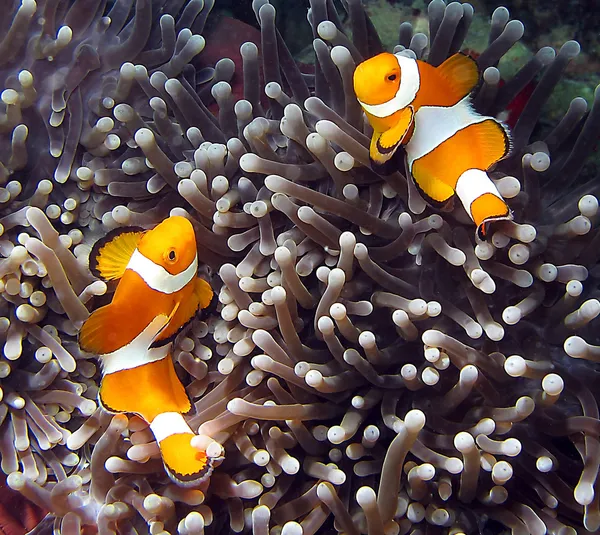
Like cichlids and other territorial freshwater fish, you can use a divider so both fish can see each other when first introduced. Or you can place one clownfish in a breeding box. Breeding boxes and dividers allow water to flow through them, ensuring that sexual hormones are able to be sensed by both fish. This will make them more receptive to one another over time.
After a few days of sharing the same aquarium, you can introduce them to one another. Keep a careful eye on the potential pair, especially if the female is significantly larger than the male.
So long as they get along and you feed them enough food, they will eventually become inseparable. Feel free to offer rich and nutritious foods, like brine shrimp and pureed squid. You may even see the pair produce eggs within months of meeting each other.
Do Clownfish Need An Anemone?
Clownfish don’t require a sea anemone. In the wild, they are frequently found living inside them in a mutually beneficial arrangement. Many organisms benefit from living in close association with one another, but the clownfish-anemone bond is one of the most famous and easy to replicate in a home aquarium.
The sea anemone gets food in the form of leftovers that the clownfish leaves behind. Clownfish will even feed their host anemone scraps sometimes, dropping crumbs and poop right onto the oral disk (mouth) of the anemone. Clownfish will also chase off butterflyfish and other predators that would pick at and eat the sea anemone.
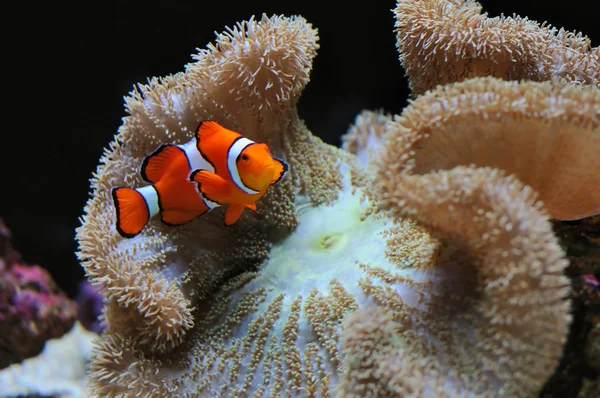
And in exchange, the sea anemone provides protection – their colorful, lovely tentacles are packed full of stinging nematocysts. Clownfish are poor swimmers; their wobbly way of moving through the water is part of their charm.
Clownfish swim mostly using their pectoral fins. This allows them to easily work their way in between the tentacles of a sea anemone. But in open water, they are easy prey for fast-moving predators like groupers or lionfish.
When spawning, clownfish also prefer laying eggs near an anemone. Usually, these eggs will be laid on a bare patch of live rock near the base of their host anemone, as you can see in this video!
What Species of Sea Anemone Do Clownfish Prefer?
Something that every aquarist setting up a clownfish tank should know is that these fish are quite picky when it comes to their anemone. There are hundreds of species of sea anemone out there. But only ten species commonly host clownfish.
Sometimes other sea anemones and even certain corals can be suitable homes for clownfish. But if you want to keep your clownfish happier, then stick to the following species:
- Long Tentacle Anemone (Macrodactyla doreensis)
- Giant Carpet Anemone (Stichodactyla gigantea)
- Saddle Carpet Anemone (Stichodactyla haddoni)
- Merten’s Carpet Anemone (Stichodactyla mertensii)
- Adhesive Sea Anemone (Cryptodendrum adhaesivum)
- Bubble Tip Anemone (Entacmaea quadricolor)
- Beaded Sea Anemone (Heteractis aurora)
- Sebae Anemone (Heteractis crispa)
- Magnificent Sea Anemone (Heteractis magnifica)
- Delicate Sea Anemone (Heteractis malu)
How Many Clownfish Should Be Kept Together?
You can keep two clownfish together or introduce anemone species that they prefer. But if you are determined to set up a clownfish aquarium, then why not keep multiple clownfish together in the same tank?
So how many clownfish can we keep in a medium to large tank? It mostly depends on the species and size, as some are more social than others. Pink Skunk Clownfish, Ocellaris Clownfish (Amphiprion ocellaris), and Percula Clownfish (Amphiprion percula) do well in groups.
And if you have a sea anemone that is large enough for the group, then they will usually share! Five clownfish is a good number for most aquariums. And for large tanks (55+ gallons), you can keep even more clownfish together!
Wrapping Things Up
Keeping clownfish in pairs or even groups is easy to do in most aquariums. Since clownfish are hermaphrodites, they are sexually flexible. So an easy way to get a pair that will lay eggs is to buy a group of young clownfish and allow them to find their own mating partner. As long as the aquarium is large enough, you can even keep the non-spawning clownfish with the mating pair.
More clownfish are rarely a problem unless you have a small tank or a very aggressive species. But keep in mind that even peaceful species have strong social hierarchies. So any new clownfish you add after the other fish have established themselves can sometimes be bullied at first.
Related Reading:

